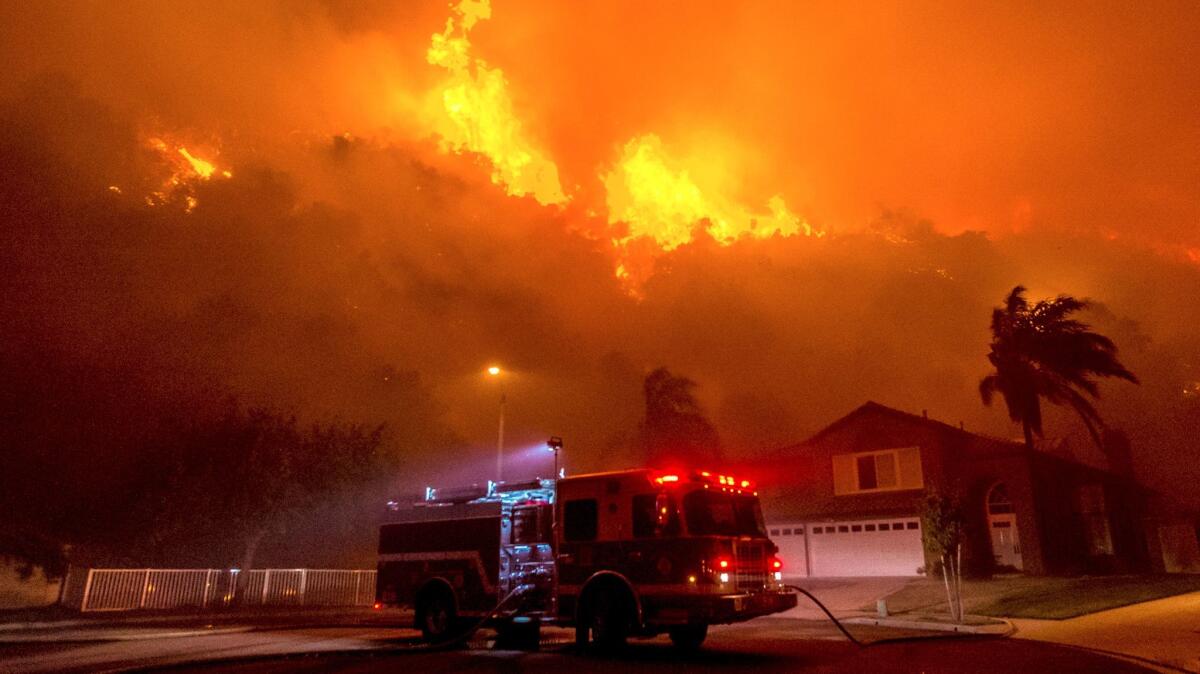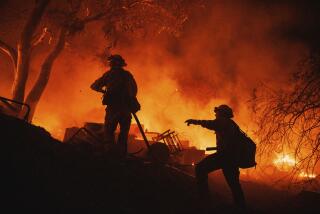Op-Ed: What the Trump administration doesn’t understand about wildfires

The major fires erupting across the West this summer — and now into fall — have burned through more than 8 million acres and $2 billion, raining lung-clogging ash on residents of Seattle, Portland, Ore., Los Angeles, Anaheim and points east. It seems the right time to carefully assess wildland fire, its climate drivers and forest-health consequences.
Alas, that’s the last thing the Trump administration is interested in doing. Its key wildfire officials — Interior Secretary Ryan Zinke, Agriculture Secretary Sonny Perdue and EPA Administrator Scott Pruitt — have refused to acknowledge the primary role that dangerous climatological factors, such as drought, heat and wind, play in energizing and propelling wildland fire. Instead, they’re fingering “radical environmentalists” who allegedly have scuttled timber sales that would have removed trees and reduced ignition sources.
The Trump triumvirate made these claims at a news conference that used the 53,000-acre Lolo Peak fire in Montana as a dramatic backdrop. Perhaps they were unaware that the forest around Lolo Peak had been repeatedly logged in recent years, and that didn’t prevent it from erupting in flame. “Large fires are not like campfires,” ecologists Dominick DellaSala and Timothy Ingalsbee observe. “They are mainly driven by extreme weather conditions, not fuels.”
When Zinke returned to Washington, he continued to ignore fire science in a memo he sent to Interior land-management staff. Among wildland experts, the directive was read as a rebuke to anyone arguing that climate change is what’s creating a “new normal” of larger, more dangerous and erratic fires.
Earth is warmer now than it has been in 1,700 years, triggering a series of extreme weather events and fueling intense wildland conflagrations.
The memo called for “new and aggressive” thinking about fire, which really amounted to just one thing: managing, or thinning “fuel,” which is to say, more logging of more trees.
Back at Lolo Peak, Zinke had revealed his real intention: to gut the regulatory authority of the National Environmental Policy Act. Zinke and crew tipped their hand when they argued against the act’s requirement for rigorous environmental-impact reports and its principled insistence on public input and oversight. Their goal is to privilege resource extraction over recreation, wildlife protection and climate-change mitigation, which may well result in less resilient forests and, of all things, more fire. President Nixon, who in 1970 signed NEPA into law, would be stunned by this effort to strip his landmark legislation’s environmental and democratic protections.
Zinke’s position is that NEPA is preventing the Forest Service from cutting down trees, and hence it’s adding to the number and intensity of wildland conflagrations. But in 2010, the Government Accountability Office reported that only 2% of Forest Service fire-reduction plans were litigated under NEPA, and the agency won most of those lawsuits. Tossing such inconvenient truths aside, Zinke, Perdue and Pruitt — and their congressional supporters — instead have ratcheted up the politicized critique of NEPA.
We already know what happens when politics rather than science motivates forest management. In the charred aftermath of the Big Blowup of 1910 — an inferno driven by hurricane-force winds across Washington, Idaho and Montana, killing 85 people and torching 3 million acres — the Forest Service caved to politicians’ hysteria and the lumber industry’s greed. It promised to throw all available human, fiscal and technological resources to snuff out all future outbreaks. In the 1930s, the can-do agency upped the ante, pledging to suppress all fires by 10 a.m. the day after lookouts spotted them. It deliberately ignored its own ecologists, who a decade earlier had concluded that fires often were essential to regenerating forest health. In fact, too much suppression only makes fires worse.
It took until the 1980s for the Forest Service to follow the lead of the National Park Service and put science at the forefront of fighting fires. As an example, look no further than the Lolo Peak fire.
When Zinke et al. denounced the Lolo Peak blaze as a symbol of all that is wrong with contemporary forest management, they got it backward. That fire signaled how science-based management can create more resilient forests in our climate-charged, fire-prone era. Firefighters at Lolo Peak carefully allowed the flames to burn through the forest’s lodgepole pine, knowing that the species required intense heat to regenerate. Fire splits open its cones so they can release their tightly packed and resin-bound seeds.
Thinning forests to create defensible space near communities has a place among the strategies required to respond intelligently to wildland fire. But decades of data show that intense logging creates more destructive fires than the ones that burn through roadless areas, parkland and wilderness. The Trump administration and Congress should be engaging in a much more nuanced discussion than the one contained in Zinke’s memo about when, where and how to mitigate wildland fire.
A starting place is the 2017 Climate Science Special Report, which scientists from 13 federal agencies compiled. It has not been approved or published by the administration (it was leaked to the New York Times). The report’s data confirm that Earth is warmer now than it has been in 1,700 years, triggering a series of extreme weather events and fueling intense wildland conflagrations. No amount of logging, scapegoating or dismantling of NEPA protections will alter that reality. Or the pressing, existential challenges it poses.
Char Miller is a professor of environmental analysis at Pomona College and author of “Not So Golden State: Sustainability vs. the California Dream” and “America’s Great National Forests, Wildernesses, and Grasslands.”
Follow the Opinion section on Twitter @latimesopinionand Facebook
More to Read
A cure for the common opinion
Get thought-provoking perspectives with our weekly newsletter.
You may occasionally receive promotional content from the Los Angeles Times.






